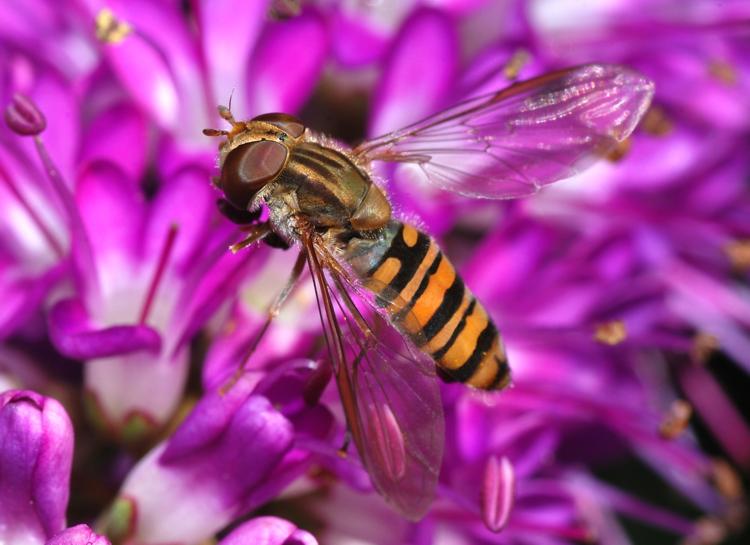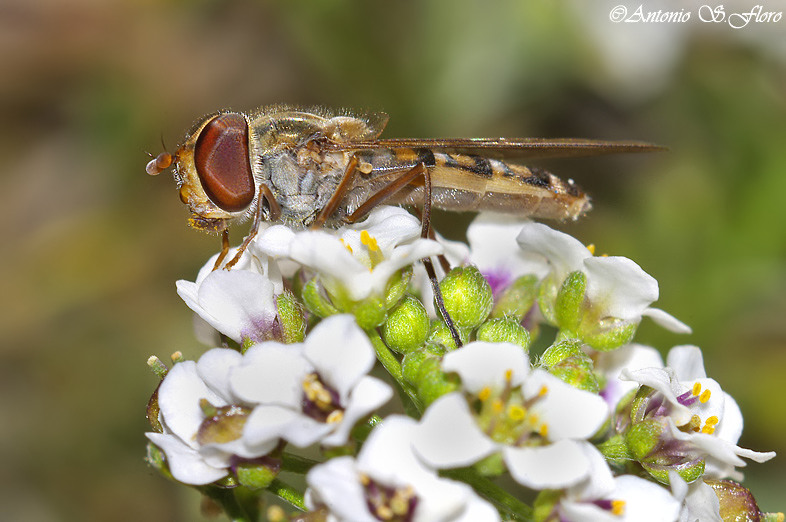Diptera.info :: Family forums :: Syrphidae
Who is here? 1 guest(s)
Page 1 of 2: 12
|
|
Episyrphus balteatus adult in January
|
|
| Tony Irwin |
Posted on 07-01-2008 22:56
|
|
Member Location: Norwich, England Posts: 7318 Joined: 19.11.04 |
Just a quick query to ask whether anyone has information about Episyrphus balteatus flying in January. A local photographer has sent me a picture of a male which landed on him on 5 January in Norfolk, England.  This is very late/early for this species here. Is it flying elsewhere in Europe this week? This is very late/early for this species here. Is it flying elsewhere in Europe this week?
Tony ---------- Tony Irwin |
|
|
|
| Andre |
Posted on 08-01-2008 00:22
|
|
Member Location: Tilburg, the Netherlands Posts: 2111 Joined: 18.07.04 |
It's a bit too cold here at the moment. But such things do happen. |
| Alvesgaspar |
Posted on 08-01-2008 00:31
|
|
Member Location: Lisbon, Portugal Posts: 573 Joined: 24.08.07 |
I go on seeing them everyday in Lisbon... Here is a shot I took about a week ago Joaquim Gaspar Lisboa Alvesgaspar attached the following image:  [112.87Kb] |
|
|
|
| crex |
Posted on 08-01-2008 00:32
|
|
Member Location: Sweden Posts: 1996 Joined: 22.05.06 |
Erik Nielsen (new member here) posted a few photos on the danish forum Fugle og Natur of a Sphaerophoria scripta larva* and then of the imago. This was from middle of December. That larva came with some Pelargonium x hortorum and developed to an adult indoors. Maybe the Episyrphus balteatus larva found a fitting plant in a warm cosy environment, perhaps indoors, and then flew outdoors and landed on that guy!?  * I think he submitted it to the gallery here |
|
|
|
| Gerard Pennards |
Posted on 08-01-2008 10:51
|
|
Member Location: Amersfoort Posts: 1914 Joined: 07.06.04 |
As you all might know, this species hibernates as an adult (mostly females). So it happens when temperature goes up a little, or when they are disturbed too much, they tend to be actif and one can see them in the middele of winter. Several years ago I found an adult female crawling in the forest on 10 cm of snow, on first Christmas day!! It was together with thousands of small Heteroptera (something like Lygaeidae), alive and also crawling on the snow. A surrealistic experience! greetings, Gerard Greetings, Gerard Pennards |
|
|
|
| crex |
Posted on 08-01-2008 11:02
|
|
Member Location: Sweden Posts: 1996 Joined: 22.05.06 |
Gerard Pennards wrote: As you all might know, this species hibernates as an adult (mostly females) ... Sorry for stupid newbie questions, but it can't only be adults hibernating, can it!? No pupas? |
|
|
|
| Tony Irwin |
Posted on 08-01-2008 12:45
|
|
Member Location: Norwich, England Posts: 7318 Joined: 19.11.04 |
Hi Gerard Can you tell me what evidence there is that this species hibernates as adults? I have seen Eristalis tenax and Eristalinus aeneus hibernating in buildings and caves, but I have never seen an Episyrphus hibernating - only flying aound or sitting on vegetation. I had always assumed that November and December individuals were active (often on Hedera blossom) through the autumn, and that individuals in March had emerged from overwintering pupae. Has anyone seen individuals or aggregations of Episyrphus actually hibernating in sheltered situations like Eristalis does? Tony ---------- Tony Irwin |
|
|
|
| jorgemotalmeida |
Posted on 08-01-2008 12:50
|
|
Member Location: Viseu - PORTUGAL Posts: 9296 Joined: 05.06.06 |
E. balteatus... Hardly I see even a fly right now. With almost 0 ?C where I am. But if I find any E. balteatus in these days, I will let know you. |
| Andre |
Posted on 08-01-2008 13:32
|
|
Member Location: Tilburg, the Netherlands Posts: 2111 Joined: 18.07.04 |
Tony Irwin wrote: Can you tell me what evidence there is that this species hibernates as adults? I have seen Eristalis tenax and Eristalinus aeneus hibernating in buildings and caves, but I have never seen an Episyrphus hibernating - only flying aound or sitting on vegetation. I had always assumed that November and December individuals were active (often on Hedera blossom) through the autumn, and that individuals in March had emerged from overwintering pupae. Has anyone seen individuals or aggregations of Episyrphus actually hibernating in sheltered situations like Eristalis does? From "Syrph the Net Species account": " Flight period: February/ November, with a number of overlapping generations; overwinters as an adult and may be found hibernating among ivy, or in caves etc. On exceptionally mild, sunny days in mid-winter this species can sometimes be found in flight - presumably specimens that have been hibernating. Sarthou et al (2006) show that the occurrence of E.balteatus adults under these conditions is linked to availability of shelter and potential resting/hibernation sites (in forest), in an agricultural landscape. This species is a pronounced migrant." So there's enough reason for discussion on this matter! Fact is that mainly female individuals are found flying in wintermonths... Edited by Andre on 08-01-2008 13:35 |
| Tony Irwin |
Posted on 08-01-2008 20:09
|
|
Member Location: Norwich, England Posts: 7318 Joined: 19.11.04 |
Many thanks to everyone who has contributed to the discussion so far. Am I right to think that hibernation is not the main way in which Episyrphus overwinters? If it was, I would expect many more to be on the wing in early spring. Tony ---------- Tony Irwin |
|
|
|
| Susan R Walter |
Posted on 09-01-2008 22:12
|
|
Member Location: Touraine du Sud, central France Posts: 1802 Joined: 14.01.06 |
Tony I have recorded Episyrphus balteatus in every month of the year at Tower Hamlets Cemetery Park in east London. I have not witnessed them tucked away hibernating, but I have seen them on extremely cold but sunny days sitting on logs in small numbers, and giving the impression that they have just emerged from under the bark or similar. They were certainly too cold to fly and could barely crawl. I easily picked them up in my fingers. I notice that the winter/very early specimens tend to be male. Edited by Susan R Walter on 09-01-2008 22:14 Susan |
| Tony Irwin |
Posted on 10-01-2008 00:11
|
|
Member Location: Norwich, England Posts: 7318 Joined: 19.11.04 |
Thanks, Susan - It's interesting that my friend's specimen was a male, and you note a predominance of males, but Gerard and Andre suggest that it is mostly the females that hibernate. Clearly there is still much to learn about even our commonest hoverflies!
Tony ---------- Tony Irwin |
|
|
|
| Andre |
Posted on 10-01-2008 13:33
|
|
Member Location: Tilburg, the Netherlands Posts: 2111 Joined: 18.07.04 |
And most published one too! Personally I only found males from may till october (in NL). I am very keen on looking at the sexe when I see first ones fly, they always are females. Perhaps, when males are found, they are remnants of the late autumn generation. By the way: it's getting warmer here, this week... keep our eyes open  |
| Juergen Peters |
Posted on 11-01-2008 06:42
|
|
Member Location: northwest Germany Posts: 14326 Joined: 11.09.04 |
Hello! In the mild winter 2006/2007 I have found numbers of Episyrphus balteatus here in Ostwestfalen/Germany in December and then again in mid February (but not January actually). A common german name for this species is "Winterschwebfliege" (winter hoverfly). Best regards, Jürgen -=-=-=-=-=-=-=-=-=-=-=-=-=-=-=-= Juergen Peters Borgholzhausen, Germany WWW: http://insektenfo... -=-=-=-=-=-=-=-=-=-=-=-=-=-=-=-= |
| Andre |
Posted on 11-01-2008 13:54
|
|
Member Location: Tilburg, the Netherlands Posts: 2111 Joined: 18.07.04 |
Any idea about the numbers of males/females you found, Juergen? |
| anto |
Posted on 14-01-2008 11:52
|
|
Member Location: Barcelona, España Posts: 211 Joined: 14.11.07 |
Barcelona,Spain,12-1-08
anto attached the following image:  [124.21Kb] Edited by anto on 14-01-2008 11:53 |
|
|
|
| Juergen Peters |
Posted on 14-01-2008 12:59
|
|
Member Location: northwest Germany Posts: 14326 Joined: 11.09.04 |
Hello, Andre! Andre wrote: Any idea about the numbers of males/females you found, Juergen? Not really, because I don't save the sex in my sighting records. I have looked at my photos from 2006/2007: the last flies in December are females, the last males date from end November. In early February 2007 there are equally males and females. Best regards, Jürgen -=-=-=-=-=-=-=-=-=-=-=-=-=-=-=-= Juergen Peters Borgholzhausen, Germany WWW: http://insektenfo... -=-=-=-=-=-=-=-=-=-=-=-=-=-=-=-= |
| Gordon |
Posted on 14-01-2008 13:41
|
|
Member Location: Lake Kerkini, Greece Posts: 1101 Joined: 02.01.08 |
For Episyrphus balteatus, I had one land on me five days ago, on the 9th, here at lake Kerkini in northern Greece, it was about 2pm, the sun had at last banished the mist and it came to see my lunch which I was eating on the west-facing 1st floor balcony of the town hall in Magalohori. |
| dipdip |
Posted on 19-01-2008 18:02
|
|
Member Location: Thunersee Switzerland Posts: 360 Joined: 17.12.05 |
I didn't see any syrphids for many weeks, not even E. tenax as last year. We had some cold days in november. Today I saw the first one this year, a Episyrphus balteatus a male. Warm Wind -> 7?C at Lake Thun. Switzerland. No Photo. There is much Hedera around. I searched for flies or pupae, but didn't find any. Looking forward for spring Maja |
|
|
|
| Juergen Peters |
Posted on 19-01-2008 18:46
|
|
Member Location: northwest Germany Posts: 14326 Joined: 11.09.04 |
Hello, Maja! dipdip wrote: this year, a Episyrphus balteatus a male. Warm Wind -> 7?C at Lake Thun. Switzerland. No Photo. Brrr..., is it cold down there...  We had 12 ?C even at 3 and 5 o'clock last night here in northwest Germany. And 14 ?C this afternoon - but with storm and rain, which prevented me to go out and look for flies. But perhaps I'll go into the garden with my UV lamp later... We had 12 ?C even at 3 and 5 o'clock last night here in northwest Germany. And 14 ?C this afternoon - but with storm and rain, which prevented me to go out and look for flies. But perhaps I'll go into the garden with my UV lamp later...
Best regards, Jürgen -=-=-=-=-=-=-=-=-=-=-=-=-=-=-=-= Juergen Peters Borgholzhausen, Germany WWW: http://insektenfo... -=-=-=-=-=-=-=-=-=-=-=-=-=-=-=-= |
Page 1 of 2: 12
| Jump to Forum: |













